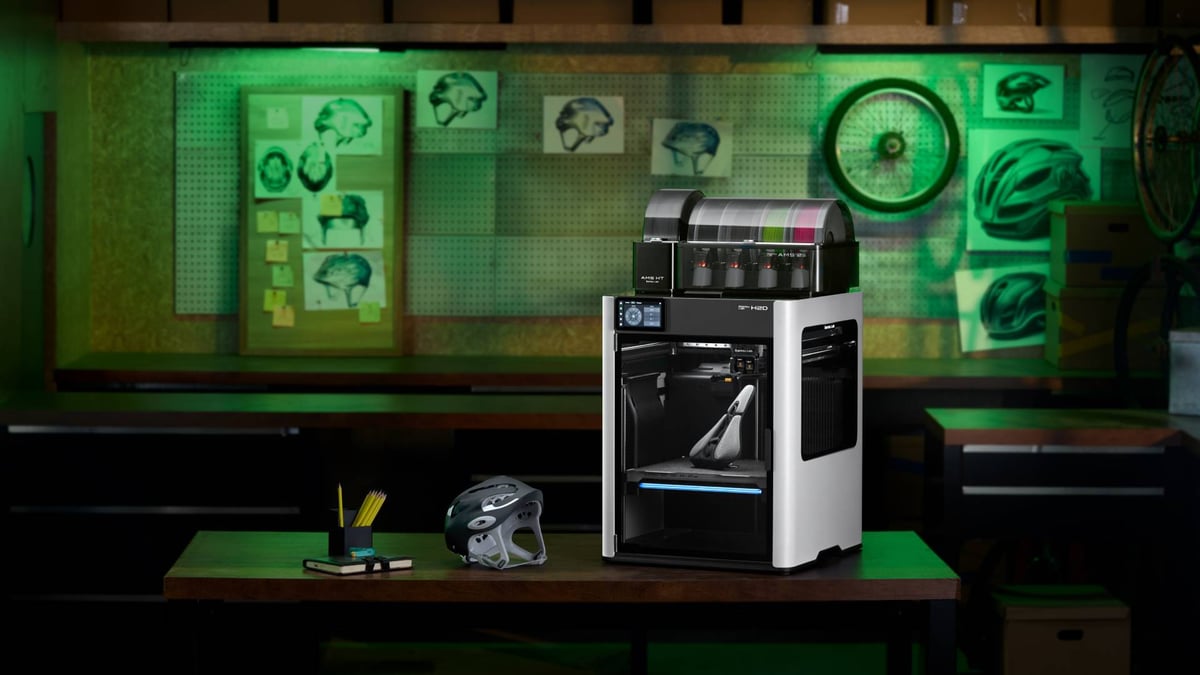Multiple leaks have borne out to show that indeed, the Bambu Lab H2D is bigger, dual extrusion, and can use a laser. But there’s so much more.
The printer is available today for $2,199 as the H2D Combo with the also-new AMS 2 Pro, and up for preorder is the H2D Laser Edition ($2,799 or $3,499 depending on the laser power you choose), which includes all of Bambu Labs’s new functions for the machine.
It’s a printer so nice (well, feature-packed) that we’ve reviewed it twice, since we’ve had it for weeks. You can scope out my view on the general experience and first impression of the cutting function, and check out our pro section editor, Carolyn Schwaar’s take on the H2D for professionals looking to upgrade their enterprise-friendly Bambu Lab X1E.
At a Glance
- Release: 2025
- Price: From $1,899
- Build Volume (mm): 325 x 320 x 325 (single nozzle) / 300 x 320 x 325 (dual nozzle)
- Temperatures (°C): 350 / 120 / 65
- Key Features: Fully enclosed, chamber temperature management, active chamber heating, dual extrusion, optional 2D cutting tools, high accuracy calibration (requires optional encoder plate), fire safety systems, safety key/killswitch
What Is The Bambu Lab H2D?
The H2D 3D printer alone packs a lot of tech in its 492 x 514 x 625 mm footprint. Bambu Lab has created a new servo-style motor for its extruder in the H2D. Called Dynasense, as opposed to stepper motors, which move in fixed increments and, depending on the system they’re implemented in, can’t do much about relaying their position or lack thereof after missed steps. Bambu Lab’s whizbang new motor does, though, and allows the printer to control the flow of filament better, the company says. Paired with Bambu Lab’s typical algorithmic smarts results in finer extrusion quality in the prints. This is something we note in our review.
Sensors and cameras permeate throughout the printer, from a dedicated nozzle camera watching for inconsistencies and errors to an Eddy current sensor monitoring the alignment of the hot ends at switching; there’s a lot happening that is not visible to keep the H2D ticking along.
Dual extrusion is a key feature, with two parallel hot ends in the H2D’s one printhead. These hardened high-flow hot ends can heat to 350 °C and can each be fed filament from lone spools or by independent AMS devices.
Active chamber heating controls the environment better for consistency over warp-prone materials, with the H2D actuating several openings on the printer to allow cool air in and vent filtered air out. You can print PLA with the door closed.
Only 300-325 mm of the 350-mm print bed width can be printed on, which is often a caveat of dual extrusion 3D printers. Overall you have 300-325 x 325 x 320 mm of build volume to work with, with a fast-heating (to 120 °C) print bed with dual-sided textured PEI plate. Bambu Lab clocks the H2D’s print speed at 1,000 mm/s with acceleration of 20,000 mm/s. Technically double the top speed of the X1E before it, but you’re unlikely to see this top speed achieved much in real-world use.

For improved 3D printing accuracy, Bambu Lab also offers an encoder plate as a separate purchase. This print plate-like sheet is covered in tiny machine-readable codes that the printer’s cameras can detect. Bambu Lab claims this sheet, combined with an advanced calibration routine, tightens the H2D’s movements to 95% confidence of 0.05 mm deviation across the whole print area.
What Else Can It Do?
In addition to the dual extrusion 3D printer, there are 2D cutting modes. There’s a blade attachment, which can cut vinyl, paper, card, and similar thin sheet materials, and two laser modules (10W and 40W) which can cut thicker materials to varying degrees.
Bambu Lab highlights the H2D Laser Edition’s safety credentials with a multitude of flame sensors, AI-based fire detection ability, harmful light-blocking windows, and required addons such as an emergency stop button and at-hand safety keys.
The H2D’s new, non-3D printing functions are handled via a new software called Bambu Suite, working with vector and bitmap file formats for outline cutting, engraving, and similar functions. As with 3D printable files, 2D files (plus projects that combine the two) will integrate into MakerWorld and become a native component of the repository. This will follow in April when the Laser Edition H2D units begin shipping.

New AMS Options
Launching today with the H2D is the AMS 2 Pro, a redesigned (but familiar-looking) AMS unit that integrates the much-requested filament drying functionality. Bambu Lab claims it’s much more than this, though, with an intelligent venting system that expels moist air and seals the unit tight to maintain the filaments’ condition. The AMS 2 Pro can heat to 65 ºC to dry filament out, with control of this happening via the printer or software on your phone or computer.
Bambu Lab now also offers a single-spool AMS HT. Sold separately, the AMS HT is compatible with the same materials as the AMS 2 Pro, but can heat to 85 ºC and can turn the spool while drying. Unlike the AMS 2 Pro, which relays humidity information via the printer and software only, the AMS HT incorporates a display giving you an at-a-glance readout of the current humidity and status of a drying job.
In the media kit for the H2D launch, Bambu Lab states AMS 2 Pro filament feeding functionality is present and functional with X- and P-series machines, meaning partial backward compatibility. Full drying functionality will come following an as-yet-to-be-determined firmware update. The AMS HT will also, eventually, be compatible with X- and P-series machines. Both may require additional components like power supplies.
The H2D expands on the X- and P-series’ number of simultaneously usable AMS units, with compatibility for four AMS (yes, the original AMS is forward compatible) or AMS 2 Pro plus eight AMS HT units. This brings the total number of usable filaments per job to 24, though we’ve yet to see how this looks and works in practice. It will, inevitably, require additional hub-type hardware that Bambu Lab has not shown yet.
As with the X- and P-series, the AMS Lite is incompatible with the H2D, due to differences in how the AMS Lite feeds and coordinates filament movement.
The Bambu Lab H2D is available and shipping today (provided you don’t mind bundling it with the AMS 2 Pro). The Laser Edition is available for preorder now, too. A basic H2D printer-only option will follow in June, costing $1,899. See more on the Bambu Lab webstore.
Read more recent news:
License: The text of "Bambu Lab Finally Launches the H2D, and There’s a Lot to Explain" by All3DP is licensed under a Creative Commons Attribution 4.0 International License.
 Stay Informed, Save Big, Make More
Stay Informed, Save Big, Make More